Vertical radiators - their types, calculation and connection
Immediately it should be said that vertical radiators are used not only as heating devices, but also as an object of decorative decoration in the room - something like an original addition to the interior. Speech in this case is about water heating, so we are interested in tubular and panel type devices made of bimetal or aluminum, as well as their operational features.
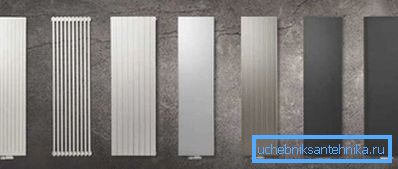
In addition, we draw your attention to some of the nuances in the installation of such heaters, and in addition we will show the video in this article.
Vertical radiators
If you want to use vertical non-standard long heating radiators indoors (up to 1,800 mm in height), you must understand that they cannot be installed under windows.
Consequently, you lose additional thermal insulation, since the warm air flow that rises up in front of the window cuts off the cold flow coming from the glass. But the same situation is created with the floor heating system, so it is not critical.
Species
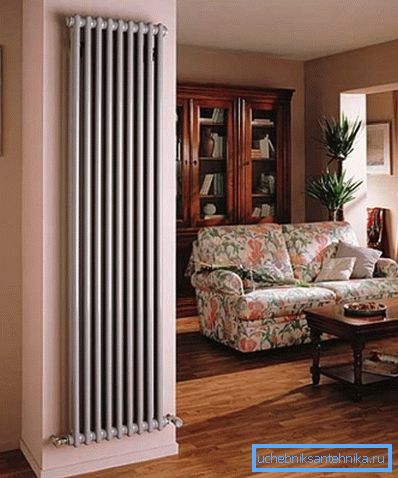
Note. In fact, any radiators for a water-heating system are vertical, since their operation takes place in just such a position. They can be made from different metals and this, in fact, depends on their weight and price. In addition, it can directly affect the efficiency of heat transfer.
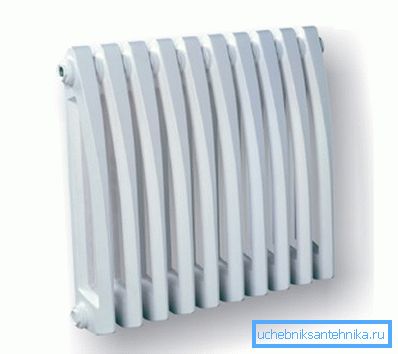
- Pig-iron vertical radiators belong to the category of tubular (columnar) sectional, that is, one section consists, as a rule, of two vertical pipes or columns interconnected and the number of these sections can be dialed at its discretion.
Cast iron is especially good in centralized heating systems, as it heats up for a long time because of its thickness, but it keeps heat for a long time, which is very convenient for occasional supply of coolant. Pig-iron devices have two major drawbacks - this is a large volume (for autonomous systems, this is too expensive, and for centralized ones it is almost imperceptible) and a large mass.
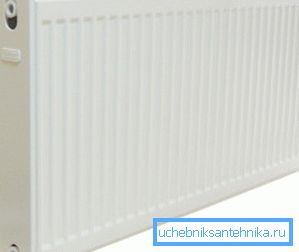
- At the moment, steel heaters are very often used, but they are made only of panel type, working according to the convection principle - they do not produce tubular models of steel, although they can be made independently, in a stainless version. Due to the large number of sizes, low weight and relatively low cost and attractive design, they are purchased very often, although in most cases it concerns only autonomous heating systems.
The main disadvantage of such heaters is their susceptibility to corrosion, so the instruction does not recommend using them in systems with centralized heating, since leakage can easily happen there due to high pressure.
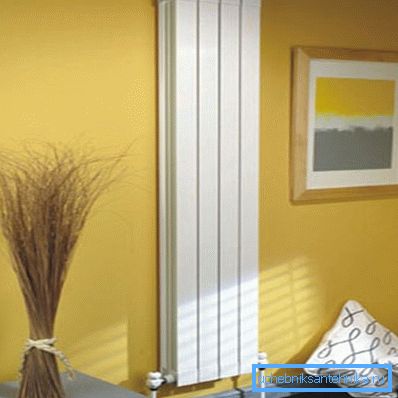
- The main advantage of aluminum models is the highest heat transfer and the smallest weight among all types of heaters of this kind, but among the advantages, of course, there are a number of disadvantages. First of all, it does not make sense to install tubular aluminum vertical radiators in centralized heating systems even in low-rise buildings, where the working pressure is not very high, since a special anti-corrosion agent should be added to the coolant, and this is possible only in autonomous systems. In addition, the cost of such a battery is quite high, but these drawbacks are more than compensating for the excellent design of the product.
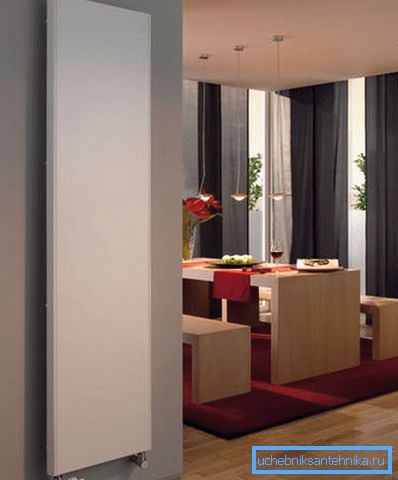
- In appearance, aluminum and bimetallic models are very similar, moreover, one and the other has a tubular type of coolant circulation, although the technical characteristics of such batteries are very different from each other.
Thus, the bimetallic structure is a tubular container, where steel is inside, and aluminum is outside, therefore, due to steel, they withstand the highest pressure that is possible in heating systems, and thanks to aluminum, their heat transfer is significantly increased.
On the plumbing market, such models are probably the most in demand, since they can be installed in systems of both autonomous and centralized heating (such heaters are also disassembled in sections).
Mirror and flat radiators
Such models, as in the top photo, are, as a rule, vertical heating radiators with a lower connection, which serve as an excellent addition to the interior of the room, at the same time heating it.
Perhaps, for decorative advantages, these are the most beautiful models, although in size they mainly correspond to other heaters, therefore, they will take up as much space as you need.
Such radiators have a tubular system of water circulation and excellent heat transfer - for example, we present below the table of ECA products.
| Panel smooth (width / height in mm) | Colour | Power, W) | Mass (kg) |
| 4001800 | White | 895 | 37.9 |
| 4001800 | The black | 900 | 37.9 |
| 5001800 | White | 1026 | 46.1 |
| 5001800 | The black | 1032 | 46.1 |
| 6001800 | White | 1198 | 54.3 |
| 6001800 | The black | 1205 | 54.3 |
ECA panel smooth
| Panel mirror (width / height in mm) | Colour | Power, W) | Mass (kg) |
| 4001800 | White | 874 | 44.1 |
| 4001800 | The black | 879 | 44.1 |
| 5001800 | White | 996 | 53.9 |
| 5001800 | The black | 1001 | 53.9 |
| 6001800 | White | 1173 | 63.9 |
| 6001800 | The black | 1180 | 63.9 |
ECA panel mirror
Calculation and connection

Before connecting the heaters to the circuit, you need to calculate their number or just the power of one unit according to the volume or quadrature of the dwelling where the installation will take place.
Suppose you install bimetallic vertical radiators of heating, then you need to look at the power of one section in the accompanying documents, but for example we take 185W, these are the Mirado parameters.
For rooms with ceilings not exceeding 2.7 m and a wall thickness of at least 0.6 m, the formula S * 100 / P is used, where S is the area of the room, P is the power of one section, and 100 is the number of watts necessary for heating m2. If we take a room 30m2, mean Knumber of sections= S * 100 / P = 30 * 100/185 = 16.2, but for certainty, of course, it is better to use 17 sections.
But such calculations can also be made by the volume of the room, especially if you have high ceilings or you use panel radiators that cannot be disassembled into sections.
It uses the formula P = V * 41,
- where P is the total power of the heater,
- V is the volume of the room
- and 41 is the number of watts required for heating m3
We take a room with the same area, but with 3m ceilings, therefore, we get V = 30 * 3 = 90m3. Hence, P = V * 41 = 90 * 41 = 3690-3.69 kW - this is the total power of one or several heaters required for such a room.
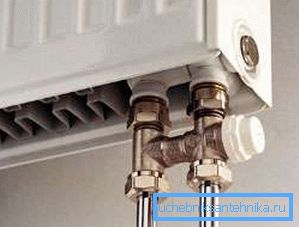
If the heating circuit is already mounted, then it is quite simple to connect a high radiator with your own hands, especially since they usually have a connection from below or from the lower sides.
It is very important that you fix it correctly, and there was no skew, and the entrances exactly corresponded to the location of the fittings of the circuit, so that the correct marking of the mounting points of the brackets is very important. Each heater must have valves and fittings (taps) at the inlet and outlet so that it can be dismantled autonomously.
Conclusion
Not all rooms do not always need the same air temperature, therefore, to regulate vertical radiators separately from each other, automatic thermostats of different designs are used. The essence of the operation of such a device is that you set the required temperature, when reached, the valve closes, and when it falls, the passage opens again.